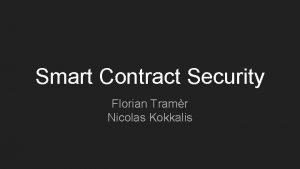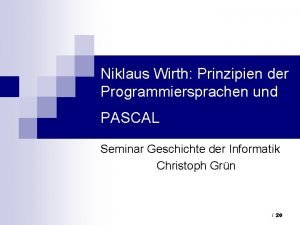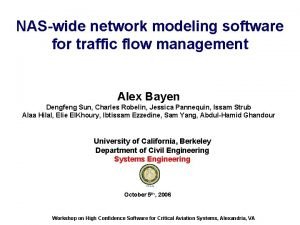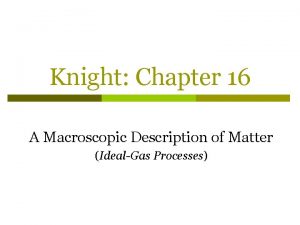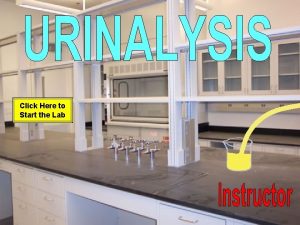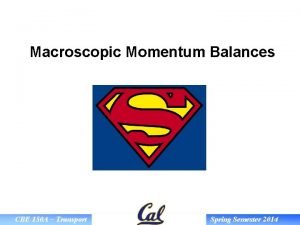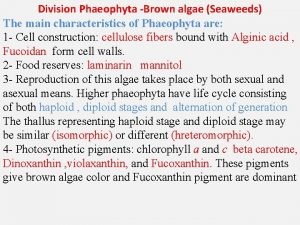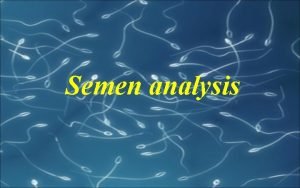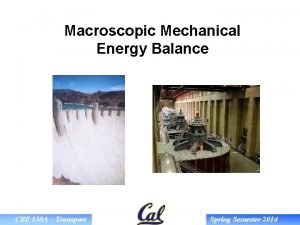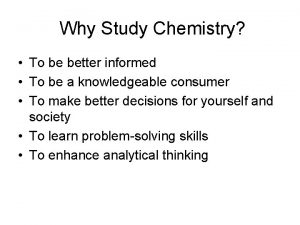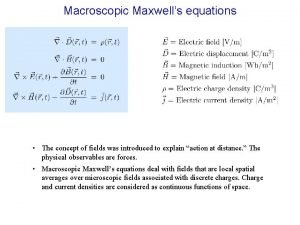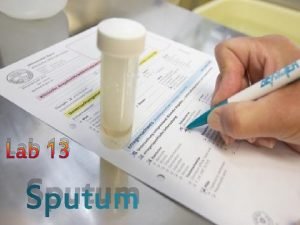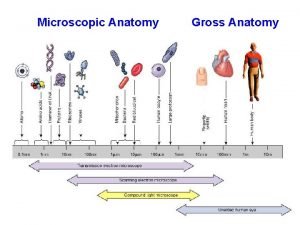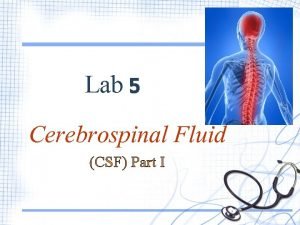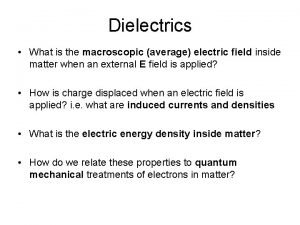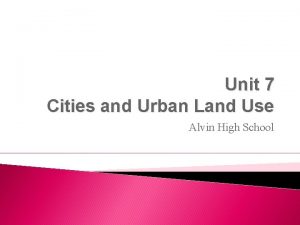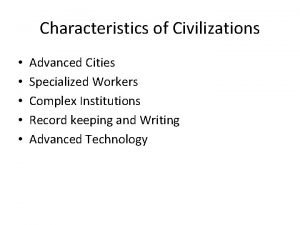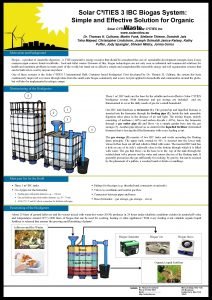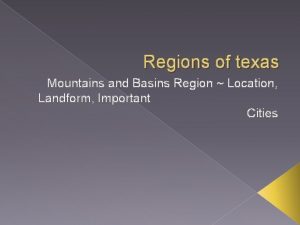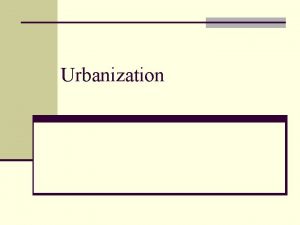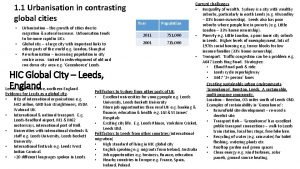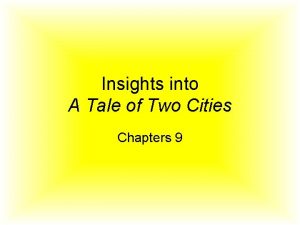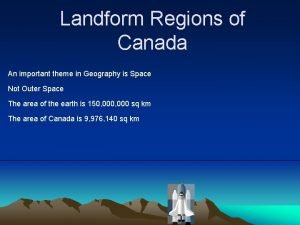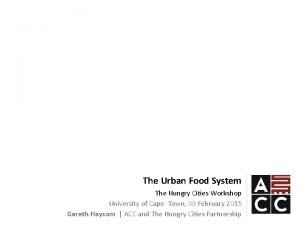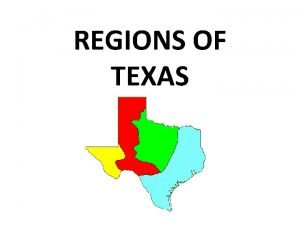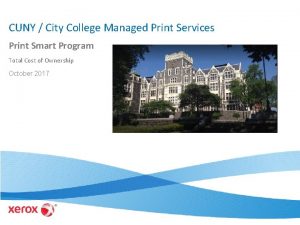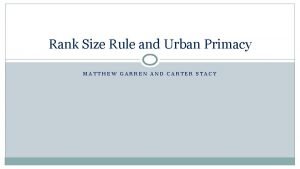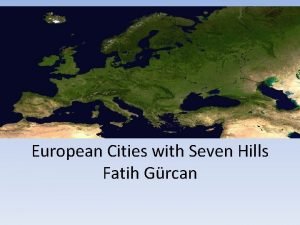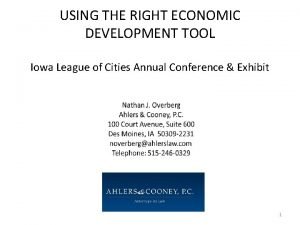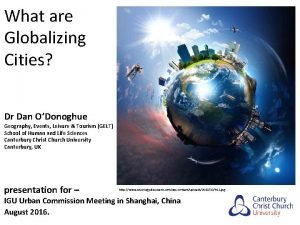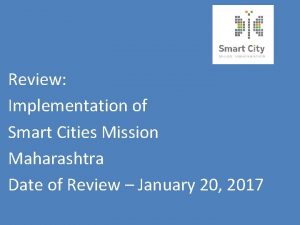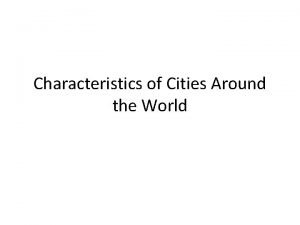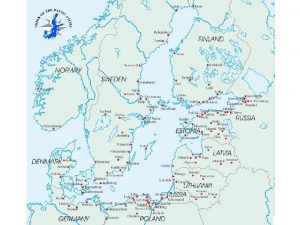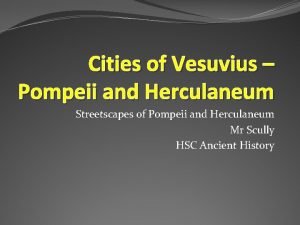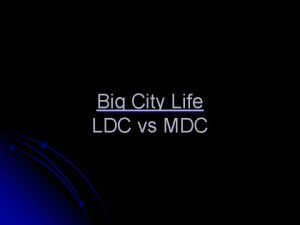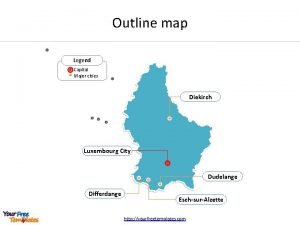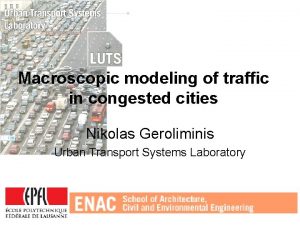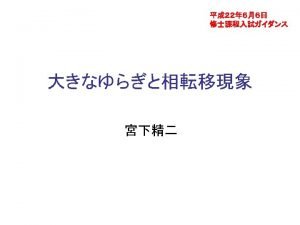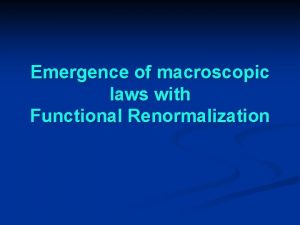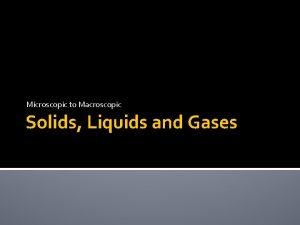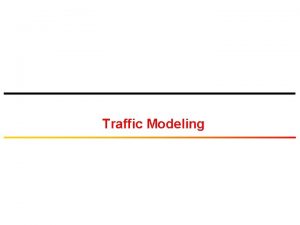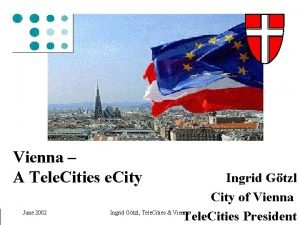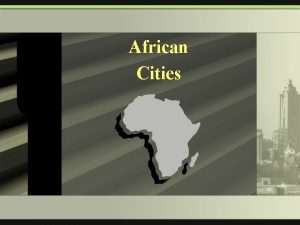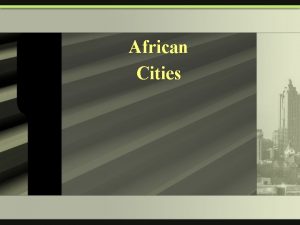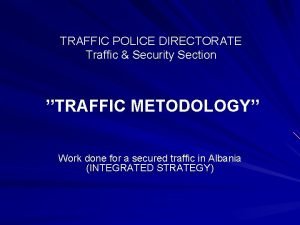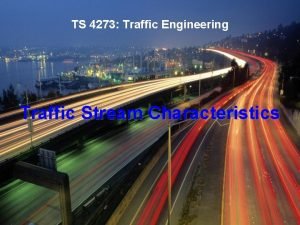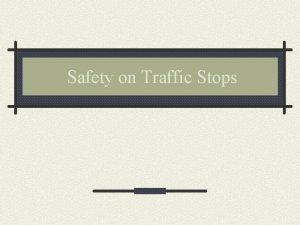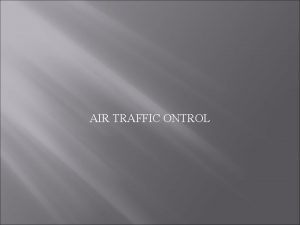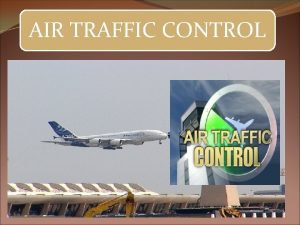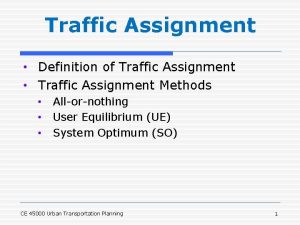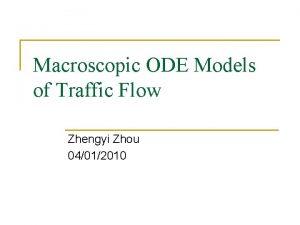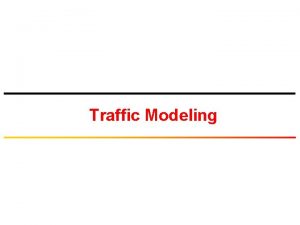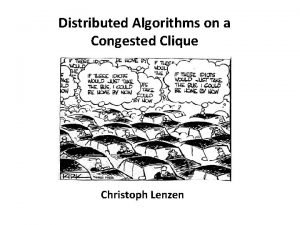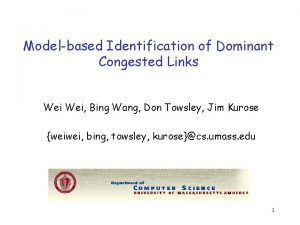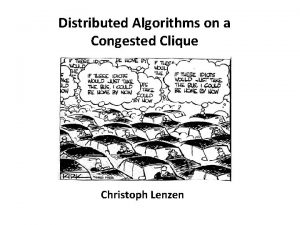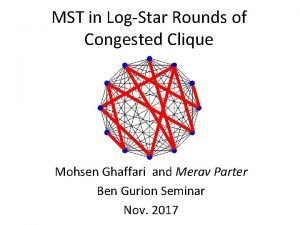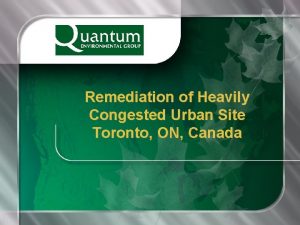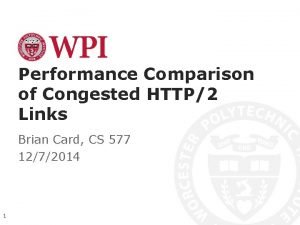Macroscopic modeling of traffic in congested cities Nikolas


















































- Slides: 50

Macroscopic modeling of traffic in congested cities Nikolas Geroliminis Urban Transport Systems Laboratory

State of the art • Two options to relieve traffic congestion in cities – The traditional approach of building new infrastructure DISADVANTAGES: economic factors, space and time limitations – Active Traffic Management (ATM) and Intelligent Transportation Systems (ITS) Increase vehicle throughput, logistics operations and safety through the use of Integrated Systems with New Technologies and advanced sensors, by continuously observing the level of congestion and make propositions and decisions in real-time.

MONITORING Heterogeneity • Spatial and Temporal • Congestion Level • Topology • Modes of transport • Sensing equipment Sparse multi-sensor data Develop travel time field and route choice information Pictures provided by Armando Bazzani (Un. of Bologna)

Traffic databases LIMITED DATA FOR URBAN STREETS

Some ideas about modeling • Disaggregate Models Ideal Gas Law – Data intensive – Unreliable Outputs • Aggregate Model – Observable – Reproducible Outputs PV=n. RT DEVELOP PHYSICALLY REALISTIC MODELS OF URBAN CONGESTION

The promise of aggregate models • Move from PREDICTION to OBSERVATION • Develop physically realistic models of urban congestion • ROBUST APPROACH PROPOSE→ MONITOR→MODIFY PV=n. RT • Information Technology “With four parameters I can fit an elephant, and with five I can make him wiggle his trunk”. JOHN VON NEUMANN

WHY MACRO? • Humans make choices in terms of routes, destinations and driving behavior (unpredictability) • Not a clear distinction between freeflow and congested traffic states. Empirical analysis of spatio-temporal congestion patterns has revealed additional complexity of traffic states (e. g. Helbing’s group work) • Need for real-time hierarchical traffic management schemes (decentralized control might not work for heavily congested systems) • Urban regions approximately exhibit a “Macroscopic Fundamental Diagram”(MFD) relating the number of vehicles to space-mean speed (or flow) • Robust linear relation between the region’s average flow and its total outflow (rate vehicles reach their destinations) • MFD is a property of the network infrastructure and control and not of the demand (time-dependent origindestination tables are difficult). 7

Macroscopic modeling of traffic in congested cities A Macroscopic Fundamental Diagram (MFD) for city traffic Existence (Simulation evidence) Existence (Empirical observations) Description of dynamics Perimeter control

Literature Review Thomson Herman & Ardekani Monotonic relationship between average speed and flow in UK Field validation of two-fluid theory Zahavi relationship between traffic intensity, road density and speed INITIAL MACROSCOPIC MODELS 1966 1967 1968 1972 Wardrop effect of road geometry and traffic control on average speed Smeed road capacity as a function of town area and density of roads Godfrey Daganzo First MFD Gridlock Model TWO-FLUID MODEL 1979 1984 1987 1969 Mahmassani et al. investigation through simulation of network level relationships Herman & Prigogine average speed is related to the fraction of moving vehicles 2007

Literature Review LIMITATIONS 19 70 For the initial models: – no description of crowded conditions Y The Gridlock Model: TODA – description of the rush hour dynamically using an MFD – development of perimeter control FOR ONE-RESERVOIR CITIES For the two-fluid model: – no description of the rush hour dynamically – no detailed sensitivity analysis for different O-Ds – no development of control strategies INITIAL MACROSCOPIC MODELS 1966 1967 1968 1972 Daganzo Gridlock Model TWO-FLUID MODEL 1979 1984 1987 2007

Fundamental Diagram (FD) for a link i • Accumulation : ni (vehs) • Travel Production : Pi (veh-km/hr) - VKT • Output-Trip completion rate (vehs/hr) Pi Qi(ni) ni • 3 Regimes I : Undersaturated II : Efficient III : Oversaturated Growing queues from the downstream link block the arrivals

Theory: Generalization to networks AGGREGATE BEHAVIOR = SCALED UP VERSION OF LINK BEHAVIOR VKT Accumulation

Key findings 1970 Production Output (Veh-km traveled/u. t) (Number of trips ending/u. t. ) L Accumulation Output (Number of vehicles in the network) • An MFD exists • Trip completions / Network flow ≃ Constant

Output Macroscopic Fundamental Diagram (MFD) Output Vehicle Accumulation Production

MFD – Sensitivity to Demand ORIGINS PER NODE DESTINATIONS PER NODE ORIGINS PER NODE Output DESTINATIONS PER NODE Vehicle Accumulation MFD is a property of the infrastructure INDEPENDENT OF O-D TABLES

MFD - Dynamics q RUN 1 n G(n) RUN 2 e =G(n) n INPUT OUTPUT ESTIMATED OUTPUT ACCUMULATION Geroliminis and Daganzo, 2007

Real World Experiment: Site Description • Fixed sensors 500 ultrasonic detectors – Occupancy and Counts per 5 min • Mobile sensors 140 taxis with GPS – Time and position – Other relevant data (stops, hazard lights, blinkers etc) 10 km 2 • Geometric data Road maps (detector locations, link lengths, intersection control, etc. ) (Dec. 2001 data)

flow Single Detectors occupancy

Aggregated Demand Average Occupancy by time-of-day Average Flow by time-of-day

Average flow All Detectors Average occupancy

speed All Detectors 197 0 Y TODA occupancy flow 1. No dependence on O-Ds 2. No traffic hysteresis

Fusing taxi and detector data An MFD exists on the part of the network covered by detectors. What about the whole network? 1. Filter for passenger-carrying taxis (i. e. full) 2. Estimation of accumulation and speed 3. Results

Filters to determine full vs. empty taxis 1. Identify passenger moves (boarding or alighting) if: • • hazard lights are ON or parking brake is used or left blinker is ON and taxi stops > 45 sec or speed < 3 km/hr for >60 sec 2. Identify full trips: • trip duration > 5 min and length > 1. 5 km • trip distance < 2 × “Euclidean distance” and

Illustration of Filter Results

Estimation of accumulation and speed Conjecture: Passenger carrying taxis use the same parts of the network as cars Then:

Full taxis = Cars

Real World Experiment: Results MFD is a property of the network independent of demand.

Max Actual Trip Completion (vh/min) Spillovers and MFD Spillovers (vhs) Speed (km/hr) Spillovers (vhs) Accumulation (vhs) Spillovers (vhs)

Properties of a well-defined MFD dr(t): pdf of individual detectors’ density in region r Q(t) and O(t): Average network flow and density Variance much higher than binomial’s WHY? 29 Correlation of link density (propagation)

An example of a “bad” MFD Average flow • Average flow Density Variance Average occupancy Strong hysteresis phenomena in freeway MFDs EXPLANATION • Different distribution of congestion (onset vs. offset) • Synchronized Phase Transitions in individual locations Freeway network of Minneapolis (USA) Average occupancy 30

Spatial Variability and Network Capacity Mazloumian, Geroliminis and Helbing (2010) – Ph. Trans. Roy. Soc. A

Congestion Spreading – Intro to Partitioning 32 Ji and Geroliminis (2012) – Trans. Res. Part B

Dynamic Partitioning Shenzhen case study 20000 taxis (25 M points/day) population Ongoing 9000 links 12 M 33 Ji and Geroliminis (2013) – Ongoing

Speed profile evolution Link Speed Histogram

Identify congestion propagation • Estimate link speeds from taxi data – 6 am - 8 am, 15 -min interval every 5 min • Identify and smooth congested links – Congested link speed <= 1/3 max speed • Spatial smoothing – If an uncongested link has more congested neighbors, this link becomes congested. • Estimate the largest connected components (CC) – breadth-first search

Congestion Propagation Small number of critical pockets of congestion Dynamic partitioning is feasible with CC

Management Options: Control CONTROL Without affecting # trips per mode Signal Control By affecting # trips per mode Urban Space Allocation Change Road Share Pricing Parking Change Mode Share

Macroscopic Perimeter control VKT 1 Neighborhood 1 B R 1 R 2 A A D Neighborhood 2 VKT 2 n 1 C R 1 R 2 D B C n 2

Multi-region cities • Partitioning + Control, BUT… j i k Control will be discussed later

Effect of Perimeter Control No Control Trips Ended With Control Trips Ended Time

Dynamics of a 2 -reservoir system n 21 n 22 • • State Variables Boundary Capacity Dynamic Equations Control n 11 n 12 R 1 R 2 output Gi(ni) ni = IN - OUT Boundary capacity Cji(ni) n

Gridlock Simulation R 2 WITH CONTROL BEFORE CONTROL R 1

Simulation Numerical Results R 2 R 1 # Trips ended With Control Before Control in R 1 89695 9947 in R 2 90218 82090 Started from R 1 15892 4037 Started from R 2 164020 88000 Total 179913 92037 PARETO IMPROVEMENT

Multimodal networks • In urban networks, buses usually share the same network with the other vehicles. • Movement Conflicts in multi-modal urban traffic systems: Modeling Congestion and developing more sustainable cities • Bus stops affect the system like variable red signals in a single lane (instead of blocking all lanes). • Increasing bus frequency decreases the flow of vehicles but can increase the flow of passengers. Performance Measures Mobility (Accessibility) Vehicle Hours Traveled Vehicle Kilometers Traveled Emissions (Environ. Impacts) Passenger Hours Traveled Passenger Kilometers Traveled Costs (Users, Providers, etc. ) Road Space Used • Competing modes • Parking • Pax vs. veh throughput MULTIMODAL CITIES 44

• • More people compete for limited urban space with different modes. We need to understand: – – How this space is used How it can be managed to improve • • Accessibility Sustainability • • • Macroscopic methodology to model traffic with different modes How throughput of passengers depends on system characteristics How to allocate city space to different transportation modes 45

Multimodal multi-reservoir system Taxis Cars Buses Cars Taxis Cars Buses Taxis Cars Taxis Cars Buses Taxis

Bus Density Network performance measures Car Density VEHICULAR FLOW Simulated data – Downtown SF Car Density PASSENGER FLOW

Infrastructure not equally available throughout a city Queues form at locations with limited capacity, but spill-over to other locations

Need not provide special lanes everywhere Spe cial Lane Example General Lane s Streets for only buses in a denseal Lane i Spec urban network anes ral L Gene Congested City Center ial La Spec ne anes L l a r Gene Provide bypasses for more efficient modes around much (if not all) congestion

DISCUSSION
 Nikolas hartshorne
Nikolas hartshorne Lucas flood
Lucas flood Dr nicolas kokkalis
Dr nicolas kokkalis Nikolas wirth
Nikolas wirth Relational vs dimensional data modeling
Relational vs dimensional data modeling Helen c. erickson nursing theory
Helen c. erickson nursing theory Network modeling software
Network modeling software All traffic solutions
All traffic solutions Inbound traffic vs outbound traffic
Inbound traffic vs outbound traffic Macroscopic description of an ideal gas
Macroscopic description of an ideal gas Urinalysis data sheet answers
Urinalysis data sheet answers Macroscopic level meaning
Macroscopic level meaning Macroscopic momentum balance
Macroscopic momentum balance Phaeophyta unicellular multicellular
Phaeophyta unicellular multicellular Macroscopic hematuria causes
Macroscopic hematuria causes Sperm count in neubauer chamber
Sperm count in neubauer chamber Macroscopic mechanical energy balance
Macroscopic mechanical energy balance Which are the main group elements
Which are the main group elements Maxwell
Maxwell Cheesy masses sputum
Cheesy masses sputum Cranial caudal
Cranial caudal Csf formation
Csf formation Definition of culuture
Definition of culuture Dielectrics
Dielectrics Suburban sprawl ap human geography
Suburban sprawl ap human geography What city became the center of hellenistic greek culture?
What city became the center of hellenistic greek culture? What is the correct equation for cellular respiration?
What is the correct equation for cellular respiration? Specialized workers characteristics
Specialized workers characteristics Biogas ibc container
Biogas ibc container Climate in the mountains and basins
Climate in the mountains and basins During the renaissance, italian cities became centers of
During the renaissance, italian cities became centers of Cosmomagical cities
Cosmomagical cities Urbanisation in contrasting global cities
Urbanisation in contrasting global cities Belled, flowery, tyrolese valley figure of speech
Belled, flowery, tyrolese valley figure of speech The gorgon's head tale of two cities
The gorgon's head tale of two cities Major cities in the appalachian region canada
Major cities in the appalachian region canada Hungry cities
Hungry cities 7 regions of texas
7 regions of texas Cuny smart
Cuny smart Rank size rule examples
Rank size rule examples Seven hill mont
Seven hill mont Iowa league of cities annual conference
Iowa league of cities annual conference Alpha beta gamma cities ap human geography
Alpha beta gamma cities ap human geography Smart cities mission projects in maharashtra
Smart cities mission projects in maharashtra Characteristics of cities
Characteristics of cities Union of baltic cities
Union of baltic cities Pompeii streetscapes
Pompeii streetscapes Difference between mdc and ldc
Difference between mdc and ldc Luxembourg major cities
Luxembourg major cities Mecca is a city in ________.
Mecca is a city in ________. Unit 3 asl
Unit 3 asl


